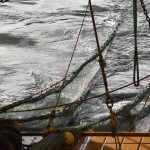According to the press communiqué the NAFC scientists worked closely with the fishing industry to develop the projects, including representatives of Shetland Fishermen’s Association, Orkney Fisheries Association and the Scottish Fishermen’s Federation. The two studies were proposed to the Scottish Industry Science Partnership, which has funded five projects during the current financial year, and they aim to bring together industry operators to address common issues.
The press released states that the studies will actively involve commercial fishing vessels and seek to highlight fishermen’s knowledge in relation to the key stocks. There will be a comparison of industry and scientific perceptions relating top the status of the North Sea stock, as in recent times there has been a significant discrepancy between the two.
The results of the study will be passed to the government and the European panel that recommends the annual quota for this important species on which many Shetland, Orkney and wider Scottish vessels depend. The study on the biology of ling reflects both the importance of this species in terms of income for Scottish vessels but also that, until now, there has been no routine sampling or survey in place for the species and very limited knowledge on which to base management advice.
NAFC head of marine science and technology Martin Robinson said that it is pleasure to see that the hard work of staff within the department has led to the funding of these projects, both because of their significance to industry but also ecause they were developed through direct collaboration with stakeholders.
He added that these projects really sum up why the centre is here,” he said. “To provide meaningful support to industry that is practical and not purely academic. Scottish Fishermen’s Federation president Alan Coghill said it was vital that fishermen engaged with scientists and whiting and ling were two stocks of great importance to Scottish fishermen but particularly those in Orkney and Shetland.








